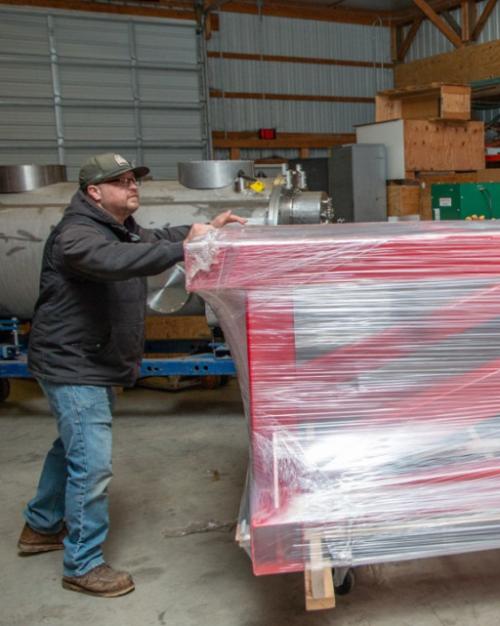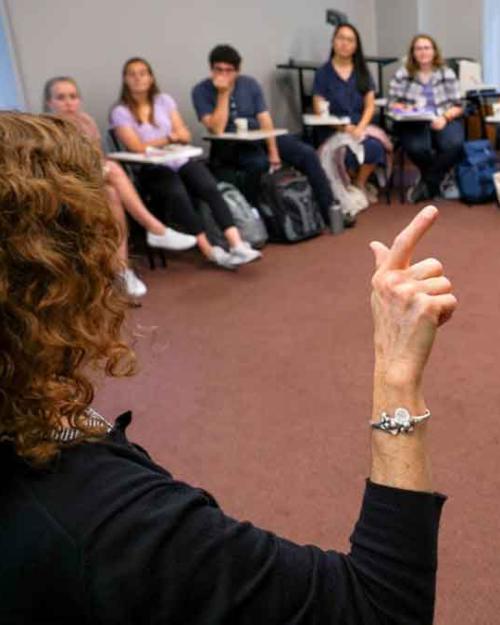Students who are interested in learning American Sign Language (ASL) have a number of new opportunities at Cornell this year.
They can now minor in ASL, take advantage of an expanded set of upper-level classes, participate in a number of ASL events on campus and be part of an active student club.
“I’ve taken an ASL class every semester and can’t imagine my college career without this experience,” said Halle Swasing ’24, a government major in the College of Arts & Sciences and co-president of the Cornell ASL Club. “I started this just as a way to fulfill the language requirement, and then I realized how awesome the classes are.”
Brenda Schertz, senior lecturer and coordinator of the ASL/Deaf Studies Program at Cornell, and one of three faculty members who teach classes, said ASL classes are immensely popular with students — the introductory classes often have a long waiting list. Along with language classes, students can take classes in ASL Linguistics; ASL Literature; Deaf Art, Film and Theatre; and Modern Deaf Culture.
“ASL/Deaf Studies as a minor can benefit students in many areas including law, medical, research, government, policy planning and in the arts,” Schertz said. “Students gain an appreciation for the diverse experiences of Deaf people, Deaf culture and issues that face Deaf people.”
Students in the minor take three required classes — Intermediate American Sign Language 2; Modern Deaf Culture and Introduction to Linguistics as well as two elective classes, one from ASL/Deaf Studies and one from a list of interdisciplinary electives, Five students will graduate with the minor next spring, she said.
“There have been a significant number of legislative and judicial initiatives that had an impact on Deaf people at the federal, state and local levels,” Schertz said, “so students with this knowledge can be involved in education, policy planning, research and health, promoting positive outcomes in all areas of Deaf people's lives.”
Swasing will graduate with the minor and so will her ASL Club co-president Lauren Celardo ’24.
“My mom was a speech therapist, so I was exposed to it a little when I was younger and I’m deaf in one ear, so I do have some experience,” Celardo said. “When I heard I could take ASL for the A&S language requirement, I thought it would be a great idea.”
The ASL Club, with 193 people on its email list, meets once a week and is beginner-friendly, Swasing said. Students play ASL games and teach basic signs. They have also supported movie nights at Cornell Cinema with films related to Deaf culture and they traveled to Rochester, home of the National Technical Institute for the Deaf, to see a play in ASL. Similar events are planned for this year, as well as a possible trip to New York City or Washington, D.C.
The ASL Club launched in 2012 as the Cornell University Deaf Awareness Project (CUDAP), a program of the Einhorn Center for Community Engagement. Then-student Jackie Rachaf ’14 founded CUDAP after she was called to a local hospital to help nurses and police communicate with a woman using ASL.
Along with the new minor, Cornell’s ASL Program is hosting the ASL Linguistics Lecture Series this semester featuring:
Julie Hochgesang, professor at Gallaudet University, “Sharing ASL data online FAIRly with CARE the ASL way - MoLo and O5S5 projects,” Sept. 28, 4:30 p.m., virtual event
Carlos Alaiza Javier, a native signer of Spanish Sign Language, "Comparing American Sign Language (ASL) with Spanish Sign Language (LSE – Lenguade de Signos Española)," Oct. 3, 4:30 p.m., 106 Morrill Hall
Deborah Chen Pichler, professor at Gallaudet University, “Bimodal Bilingualism,” Nov. 9, 4:30 p.m., 106 Morrill Hall
And the program will collaborate with students in the ASL Club to offer special events in the spring semester, which will include a celebration of the program’s fifth year on campus, an ASL performance and an ASL/Deaf Studies Lecture Series.
Schertz said there has been a tremendous increase in public awareness about inclusion and access for all people, including people with disabilities.
“ASL/Deaf Studies has been around for some time, but did not attract much media attention until the last few years,” she said. “Nyle DiMarco of Dancing with the Stars fame and Marlee Matlin of the film “CODA” brought the spotlight to Deaf people and ASL/Deaf Studies.”
Both Swasing and Celardo are glad the minor was approved before they graduated.
Celardo, a bio major, plans to attend medical school, and Swasing plans to go to law school. Both say they think their knowledge of ASL and Deaf culture will be helpful in whatever career they choose, not that they could replace an interpreter, but that their clients or patients “might feel more comfortable knowing that they understand the basics of where they’re coming from.”





